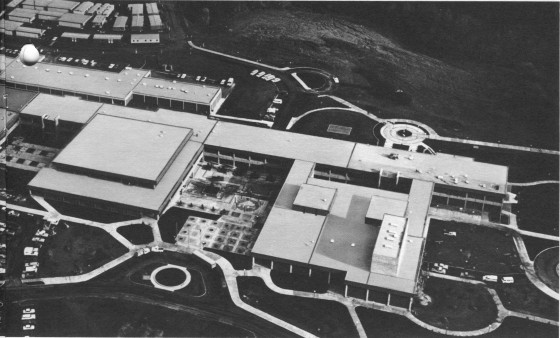Exploring the life of Mt. Hood’s principal architect
Gail Woodford said that architecture “is something that is left of you after being gone.”
This is something she thinks about when she drives past one of her father’s most elaborate projects as an architect: Mt. Hood Community College.
Recently, Gail and her husband Lou Woodford were sorting through her late father’s belongings and they came across some notebooks containg records of the projects he worked on. Within these notebooks, there was even a videotape containing an interview between Donald Lutes and MHCC students 10 years after the college’s completion.
Coming across these notebooks, Lou Woodford thought, “It would be a shame to lose that history simply because we put it in the recycling.”
Instead, the Woodfords brought the notebook to MHCC President Debbie Derr to see what she thought about it. While Derr looked it over, the Woodfords explored the college that her dad designed. Wandering around campus, Gail thought to herself, “Dad would be happy about this,” referring to the state of the campus.
Her husband said, “When we came back to the office, she (Derr) was still sitting on the couch, flipping through the notebook.” According to Gail, the president was even beginning to draw a crowd.
“When I saw that, I thought, ‘Wow, this was worth it. Somebody actually does care about this.’”
Lutes not only designed the college but also designed many buildings in the Springfield/Eugene area, including: Churchill High School, Springfield High School, Lane County Jail, and the Willamette Hospital. He would also help out during times of crisis. When the 1964 Good Friday Earthquake occurred in Anchorage, Alaska, he was one of the architects redesigning and repairing some of the buildings. When the tsunami caused by that earthquake wrecked parts of Crescent City, Calif., he helped out there, too.
Gail Woodford talked about a potting shed that her dad designed for her; it is still standing in her backyard. She said, “I always joke, ‘If there is ever an earthquake or tornado, that’s where we are gonna be.’ It’s never going anywhere. He wouldn’t skimp (on his projects).”
Lutes grew up in San Diego. He started learning architecture in high school, taking up hobbies such as radio-controlled airplanes and the Marine ROTC program. Near the end of WWII, when Lutes was getting out of high shchool, he was drafted into the Army Corps of Engineers as a second lieutenant. He served in Japan, and was a part of the occupational forces. After WWII, Lutes came back to Springfield, Ore., the last place he would call home — only to be recalled a couple of years later for the beginning of the Korean War.
Architecture was still prevalent in his life. Among the notebooks the Woodfords discovered were “sketches of a PX wagon (old school pharmacy on wheels) on the back of an old Korean War map. He had to have drawn it in his spare time,” Lou Woodford said.
In between the wars, Lutes attended Stanford University, and later attended Washington State University, studying architecture at both colleges. The same could be said for Lutes’ term at the University of Oregon – where he got his degree in architecture – but he had the added benefit of meeting Donnie Wageman there, who became his wife of 57 years.
In Korea, Lutes was a licensed architect. According to the Woodfords, he even had the chance to design a house for a Korean general before coming back to the states.
“From the time he was in high school, he was pretty sure that he was going to be an architect,” said Lou Woodford.
When he designed things, “he had an image in mind for each one and what he expected it to be like.”
According to Gail Woodford, Lutes designed his buildings to last, but also built buildings that fit the surroundings. This can be seen at MHCC, how the stairs are built into the slopes, allowing for accessible entrances to both the second and first floor of the college from ground level.
He didn’t want MHCC to be another building on top of the land, she said. “He wanted it to be a building that was a part of the land, To match the surroundings character.”
Her husband said Lutes was “green” way before anybody else in that time period.
Gail Woodford, 13 years old at the time, did not have many memories about MHCC from the time her father was working on its design. “It was just Dad going to work,” she said. She remembers their dinner conversations being more focused toward what was going on at the college, but no specifics. What she remembers most from the time “is that he had meetings every Thursday at the college, We (her and her two siblings) would hear him coming home at 1 or 2 a.m.”
She said, “I think he would be so pleased to know that everyone is excited about this. Pleased to know that 60 years after he designed this place (MHCC), it looks how he wanted it to look and it functions the way he imagined it would. That would make him very happy.”
Part One – MHCC: How it all started
Part Two – Exploring the life of Mt. Hood’s principal architect
Part Three – Mt. Hood’s Gresham campus built to survive quakes
Part Four – College to reach crucial milestone in time for bond
To view more of Donald Lutes’ notebook. click here.



Leave a comment